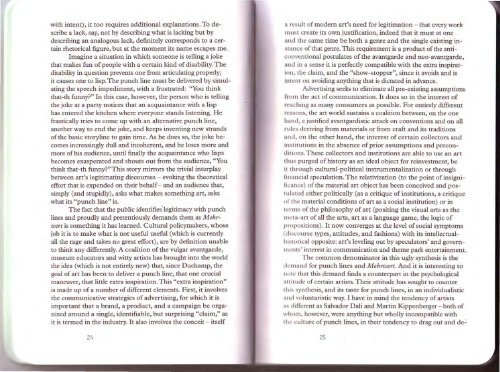Create successful ePaper yourself
Turn your PDF publications into a flip-book with our unique Google optimized e-Paper software.
with <strong>in</strong>tent), it too requires additional explanations. To describe<br />
a lack, say, not by describ<strong>in</strong>g what is lack<strong>in</strong>g but by<br />
describ<strong>in</strong>g an analogous lack, def<strong>in</strong>itely corresponds to a certa<strong>in</strong><br />
rhetorical figure, but at the moment its name escapes me.<br />
Imag<strong>in</strong>e a situation <strong>in</strong> which someone is tell<strong>in</strong>g a joke<br />
that makes fun of people with a certa<strong>in</strong> k<strong>in</strong>d of disability. The<br />
disability <strong>in</strong> question prevents one from articulat<strong>in</strong>g properly;<br />
it causes one to lisp. The punch l<strong>in</strong>e must be delivered by simulat<strong>in</strong>g<br />
the speech impediment, with a frustrated: "You th<strong>in</strong>k<br />
that-th funny?" In this case, however, the person who is tell<strong>in</strong>g<br />
the joke at a party notices that an acqua<strong>in</strong>tance with a lisp<br />
has entered the kitchen where everyone stands listen<strong>in</strong>g. He<br />
frantically tries to come up with an alternative punch l<strong>in</strong>e,<br />
another way to end the joke, and keeps <strong>in</strong>vent<strong>in</strong>g new strands<br />
of the basic storyl<strong>in</strong>e to ga<strong>in</strong> time. As he does so, the joke becomes<br />
<strong>in</strong>creas<strong>in</strong>gly dull and <strong>in</strong>coherent, and he loses more and<br />
more of his audience, until f<strong>in</strong>ally the acqua<strong>in</strong>tance who lisps<br />
becomes exasperated and shouts out from the audience, "You<br />
th<strong>in</strong>k that-th funny?"This story mirrors the trivial <strong>in</strong>terplay<br />
between art's legitimat<strong>in</strong>g discourses - evok<strong>in</strong>g the theoretical<br />
effort that is expended on their behalf - and an audience that,<br />
simply (and stupidly), asks what makes someth<strong>in</strong>g art, asks<br />
what its "punch l<strong>in</strong>e" is.<br />
The fact that the public identifies'1egitimacy with punch<br />
l<strong>in</strong>es and proudly and pretentiously demands them as Mehrwert<br />
is someth<strong>in</strong>g it has learned. Cultural policymakers, whose<br />
job it is to make what is not useful useful (which is currently<br />
all the rage and takes no great effort), are by def<strong>in</strong>ition unable<br />
to th<strong>in</strong>k any differently. A coalition of the vulgar avantgarde,<br />
museum educators and witty artists has brought <strong>in</strong>to the world<br />
the idea (which is not entirely new) that, s<strong>in</strong>ce Duchamp, the<br />
goal of art has been to deliver a punch l<strong>in</strong>e, that one crucial<br />
maneuver, that little extra <strong>in</strong>spiration. This "extra <strong>in</strong>spiration"<br />
is made up of a number of different elements. First, it <strong>in</strong>volves<br />
the communicative strategies of advertis<strong>in</strong>g, for which it is<br />
important that a brand, a product, and a campaign be organized<br />
around a s<strong>in</strong>gle, identifiable, but surpris<strong>in</strong>g "claim," as<br />
it is termed <strong>in</strong> the <strong>in</strong>dustry. It also <strong>in</strong>volves the conceit - itself<br />
2/j<br />
II result of modern art's need for legitimation - that every work<br />
Illust create its own justification, <strong>in</strong>deed that it must at one<br />
111 1 the same time be both a genre and the s<strong>in</strong>gle exist<strong>in</strong>g <strong>in</strong><br />
Illnce of that genre. This requirement is a product of the anti<br />
'onventional postulates of the avantgarde and neo-avantgarde,<br />
II I d <strong>in</strong> a sense it is perfectly compatible with the extra <strong>in</strong>spiraton,<br />
the claim, and the "show-stopper", s<strong>in</strong>ce it avoids and is<br />
illl 'nt on avoid<strong>in</strong>g anyth<strong>in</strong>g that is dictated <strong>in</strong> advance.<br />
Advertis<strong>in</strong>g seeks to elim<strong>in</strong>ate all pre-exist<strong>in</strong>g assumptions<br />
Il'om the act of communication. It does so <strong>in</strong> the <strong>in</strong>terest of<br />
I 0 h<strong>in</strong>g as many consumers as possible. For entirely different<br />
I '080ns, the art world susta<strong>in</strong>s a coalition between, on the one<br />
hnnd, a justified avantgardistic attack on conventions and on all<br />
I III s deriv<strong>in</strong>g from materials or from craft and its traditions<br />
In I, on the other hand, the <strong>in</strong>terest of certa<strong>in</strong> collectors and<br />
<strong>in</strong>stitutions <strong>in</strong> the ahsence of prior assumptions and precondili<br />
ns. T hese collectors and <strong>in</strong>stitutions are able to use an art<br />
Ihus purged of history as an ideal object for re<strong>in</strong>vestment, be<br />
il lhrough cultural-political <strong>in</strong>strumentalization or through<br />
llilancial speculation. The relativization (to the po<strong>in</strong>t of <strong>in</strong>signi<br />
II 'ui1ce) of the material art object has been conceived and poslulu<br />
ted either politically (as a critique of <strong>in</strong>stitutions, a critique<br />
or lhe material conditions of art as a social <strong>in</strong>stitution) or <strong>in</strong><br />
I . rms of the philosophy of art (posit<strong>in</strong>g the visual arts as the<br />
III ' lo-art of all the arts, art as a language game, the logic of<br />
(ll'Opositions) . It now converges at the level of social symptoms<br />
(dis ourse types, attitudes, and fashions) with its <strong>in</strong>tellectualhi<br />
Hlorical opposite: art's level<strong>in</strong>g out by speculators' and govern<br />
III 'nts' <strong>in</strong>terest <strong>in</strong> communication and theme park enterta<strong>in</strong>ment.<br />
T he common denom<strong>in</strong>ator <strong>in</strong> this ugly synthesis is the<br />
d 'mand for punch l<strong>in</strong>es and Mehrwert. And it is <strong>in</strong>terest<strong>in</strong>g to<br />
IIOle that this demand f<strong>in</strong>ds a counterpart <strong>in</strong> the psychological<br />
III i lude of certa<strong>in</strong> artists. Their attitude has sought to counter<br />
I his synthesis, and its taste for punch l<strong>in</strong>es, <strong>in</strong> an <strong>in</strong>dividualistic<br />
{lild voluntaristic way. I have <strong>in</strong> m<strong>in</strong>e! the tendency of artists<br />
" different as Salvador Dati and Mart<strong>in</strong> Kippenberger - both of<br />
whom, however, were anyth<strong>in</strong>g but wholly <strong>in</strong>compatible with<br />
I II· ulture of punch l<strong>in</strong>es, <strong>in</strong> their tendency to drag out and de':<br />
25








